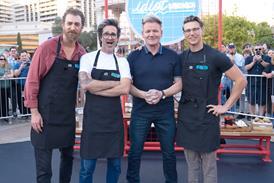The Broadcast Tech Survey 2011: Independent production companies
While technology may not be the independent TV producer’s core business, 58% of those who responded to our survey keenly embrace it, with 29% describing themselves as “enthusiasts” and another 29% as “early adopters”.
In contrast to, say, 10 or 20 years ago, when many of the technology-related elements involved in making a TV show might have been outsourced, producers seem to be involving themselves far more in buying and using new technology.
“We’ve had to become more technical for cost reasons and because it’s all so complicated. With digital camera choices and file-based workflows, you really need to know what you’re doing,” says Ulla Streib, director of operations at Darlow Smithson.
File-based workflow
Just under half of all producers surveyed placed file-based workflow at the top of their list of serious technology conversations for 2011/12 - the events in Japan paving the way for producers to explore whole new ways of working.
As Wall to Wall managing director Richard Thomson notes: “There’s nothing like a kick in the pants to say sooner rather than later. Our over-reliance on tape started to look dubious when supply was affected beyond our control and the cost for master tape formats rose. We’ve started to think a lot more about cardbased [formats.”
That’s not to say producers are embracing the format wholeheartedly - many who have worked with tapeless tell stories of lost or corrupted data. Streib recalls a recent shoot when a crew using five file-based cameras shot an explosion.
“It was literally dumped onto a desktop [in a way that meant] we didn’t know what had been shot. We could also only find four files.”
Atlantic Productions, whose highend projects include BSkyB’s 3D dinosaur spectacle Flying Monsters, has employed file-based workflows on the majority of its projects for more than a year and is well aware of the extra management involved in the handling of digital files.
“On 3D shoots, it’s easier to justify the cost of employing a data wrangler because you’re dealing with twice as much stuff,” says Atlantic head of operations Ruth Sessions.
But, she adds: “Having enough people and time on location is a challenge and it can add up to three hours onto the end of each day because it can take this long to back up all your rushes.”
Storage and archiving
File-based workflow-related issues also scored highly in our survey. Storage and archiving was a concern for 34% of respondents.
Atlantic inhouse facilities head Matt Pearson says of its current back-up process: “With the 3D, we back up rushes twice to laser drives. One of these goes to the post house and one to Atlantic’s offices. The post house version then gets backed up again on a large server. The conform is then done from that big server. At the end of the production, Atlantic will then store a copy on LTO.”
Even a company as technically savvy as Atlantic is still using tape-based LTO for long-term storage. Transferring drives to LTO - a magnetic tape format - for long-term storage is another budgetary concern that should arguably have been eliminated from the file-based workflow by now.
“If you speak to producers about storage, around 90% will say it’s on Digibeta in a vault somewhere,” says Thomson. “How many producers are storing masters digitally at a Red Bee-type place? Not as many as there should be. Copies are stored digitally, rather than masters.”
According to Thomson, the reluctance to move away from tape-based storage formats can in part be attributed to insurance considerations.
“If your content is being stored digitally, the insurance company wants to know that there’s not just one copy but multiple copies in diverse locations to minimise the risk from corruption,” he says.
In general, though, Thomson and others feel that there are still questions to be answered before they commit to storing their valuable content digitally. For example, how robust is digital storage and what are the long-term security issues?
Cameras
Conversations around digital cameras were a hot topic for 34% of our respon dents in this category and, because of work fl ow concerns, the purchase or hire of kit is not always the preserve of the DoP or director. “The choice of camera infl uences the workfl ow so much. A decision on the workfl ow and cameras used has to take place before you agree on the technical deliverables to the broadcasters, and form part of the negotiation process when it comes to the budget,” says Streib. Another reason for the producer’s preoccupation with digital cameras might stem from the fact that there are now so many of them, with a new unit seemingly released every week. The market in general is also much less defi ned, with crews using lenses to mix up prosumer and domestic cameras with professional ones.
HD
An overwhelming 80% of producers are now shooting on HD and this conversation dominates the agenda for a clear majority (56%) of our respondents.
While this has now become the de facto format for many, there are clearly some areas, such as daytime and news, that are still making the transition. And let’s not forget the number of production companies supplying the multichannel arena, where HD might not yet be a delivery requirement.
Peter Savage, managing director of finance and leasing company Azule Finance, notes that the price of second hand SD kit has dropped exponentially:
“Cameras that once cost £40,000 a couple of years ago you can’t give away now. No one uses them any more,” he says.
In Savage’s view, producers should not get too comfortable about investing in newer formats either. “You will never see kit lasting as long as it did in SD again. And I think that HD in a tape format will have a much shorter lifeline than anticipated,” he says.
3D
Only 2% of production companies claim to be “leading the way in 3D”, according to our survey, with many more either waiting to see what happens (46%) or ruling it out altogether (24%).
For companies like Atlantic that are operating at the high end, working on projects with big budgets, it makes sense, but for the majority of TV production companies, it can often mean producing 3D on a 2D budget.
Streib’s view on the subject is representative: “I would love to do a 3D TV series and we’re acquiring the knowledge and know-how through talking to people and assessing our options. But so far, we’ve not been able to persuade broadcasters to finance it to the value we need. It’s just very expensive.”


























No comments yet